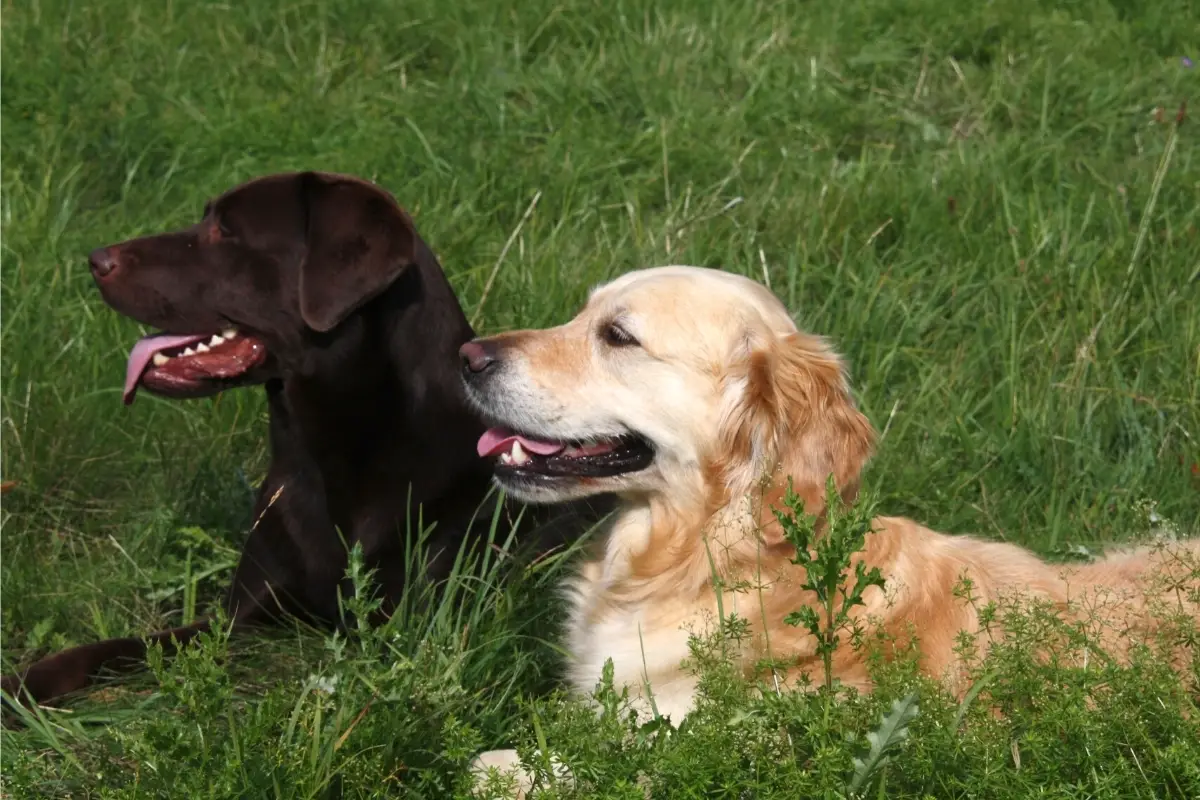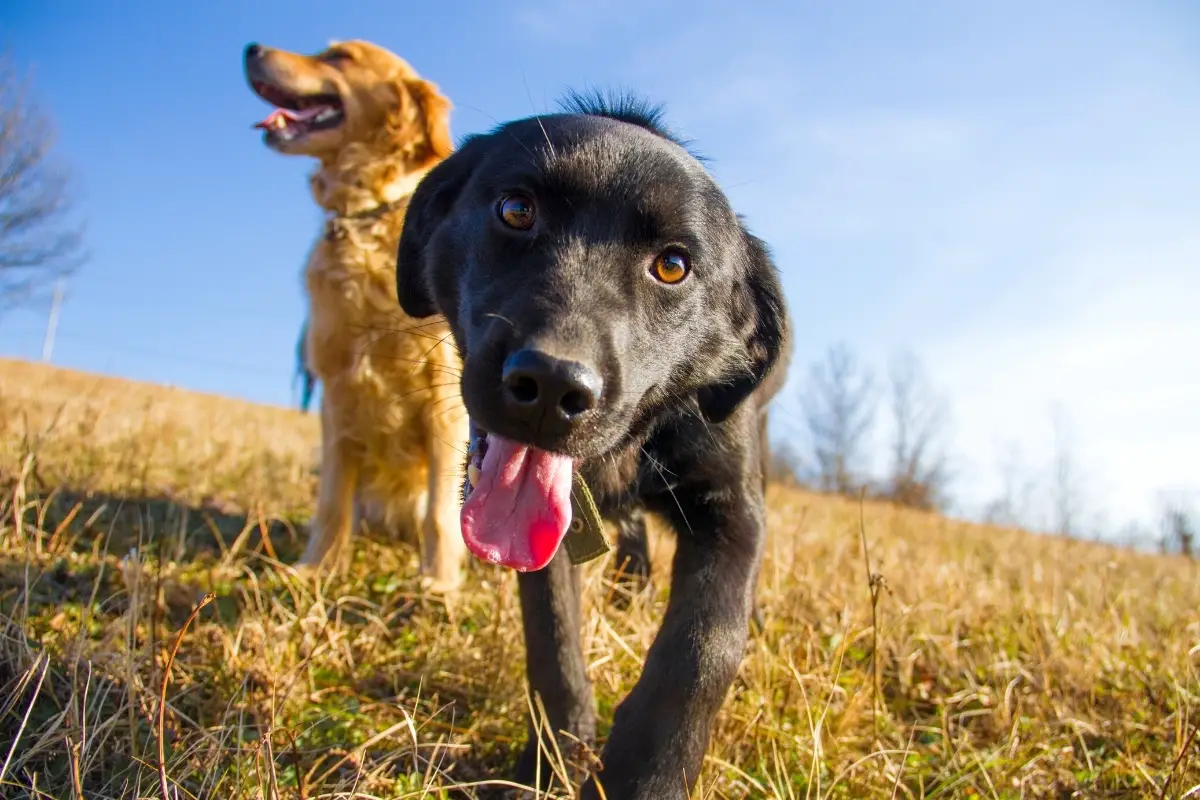When comparing a Golden Retriever vs Labrador Retriever, note that the Labrador has a short, dense, weather-resistant coat; while the Golden has a long double layered coat. Both retriever breeds are very friendly, active, and powerful dogs. Both are popular among those who want a loving family dog and those who enjoy active lifestyles. Purebred Golden Retrievers have a golden color while Labradors can vary from black, chocolate, and yellow.
These dog breeds are both very popular and are similar in many aspects. They do have a few key differences that are worth considering though, so read on to learn more about these two breeds.
Table of Contents
Size & Physicality
The Lab is an enthusiastic athlete that requires lots of exercise (like swimming and marathon games of fetch) to keep them physically and mentally fit. A Lab that doesn’t get enough exercise is likely to engage in hyperactive and/or destructive behavior to release its pent-up energy.
The breed’s favorite activities are retrieving and swimming. Labs also love to burn up energy on hunting trips or running with owners, as well as by participating in canine sports such as agility, obedience, tracking, and dock diving.
Many Labs also work hard in important roles such as search-and-rescue, drug and bomb detection, and as service and assistance dogs. Their friendly and active natures make them well suited for these jobs.
Goldens also need plenty of daily exercise. A dog of either breed who doesn’t get enough exercise is likely to engage in undesirable behavior.
These breeds make great companions on long runs and bike rides.
Consultation with a vet is recommended before starting strenuous or high-impact activities that might cause stress to the dog’s bones and joints. Many Goldens happily get their exercise through daily outdoor activities with the family.

These two dog breeds have many similar characteristics, especially when it comes to their size. Check out the tables below for a comparison of some of their traits.
Size & Weight Comparison Chart
| Labrador Retriever | Golden Retriever |
| Height: 22.5-24.5 inches (male) 21.5-23.5 inches (female) Weight: 65-80 pounds (male) 55-70 pounds (female) | Height: 23-24 inches (male) 21.5-22.5 inches (female) Weight: 65-75 pounds (male) 55-65 pounds (female) |
Health Comparison Chart
| Labrador Retriever | Golden Retriever |
| Life Span: 10-12 years Recommended Health Tests From the National Breed Club: Hip Evaluation Elbow Evaluation Ophthalmologist Evaluation EIC DNA Test Possible Health complications: A condition called exercise-induced collapse (EIC) can occur in some young adult Labs; A DNA test allows breeders to identify carriers and plan breedings to avoid producing the disease. Like other large, deep-chested dogs, Labs can develop a life-threatening stomach condition called bloat. | Life Span: 10-12 years Recommended Health Tests From the National Breed Club: Hip Evaluation Elbow Evaluation Cardiac Exam Ophthalmologist Evaluation Possible Health complications: Eye conditions; certain heart diseases The Golden’s ears should be checked weekly for signs of infection, and the teeth should be brushed often. |
Cost
Adoption is a cheaper avenue for families who want to save some money or rescue a puppy/full-grown dog. See our list of Golden Retriever Rescue Organizations. Searching for agencies or shelters in your nearest city is the best source for up-to-date information on availability.
It is not common to find purebred Golden or Labrador retrievers for adoption since they are one of the most popular dog breeds in the United States. Mixes are fairly common though, and you can often find Lab mixes in shelters.
The cost for purebred Golden Retriever puppies range from $500- $3,000 with an average around $2,000. The cost for purebred Labrador puppies are a little lower ranging from $300- $1800 with an average around $1,000.
Grooming costs $60-120 depending on the provider and level of care required by the owner. Golden retriever grooming may be higher due to the longer coat. Veterinary costs associated with owning either of these breeds include testing regularly for health conditions, flea, and heartworm prevention, and check-ups. This usually adds up to around $120, but it can be much higher if there is a problem.
If owners would like to spay or neuter their dogs on top of microchips and licensure per year, that could cost about $350 extra.
To learn more about the cost of owning a Golden Retriever, check out How Much Does a Golden Retriever Cost.
Temperament

Labs and Golden retrievers are famously friendly. They are affectionate housemates who bond with the whole family, and they socialize well with neighbor dogs and humans alike. Both are exuberant, very energetic breeds that can be mildly protective and usually bark only when necessary.
Early socialization and puppy training classes are vital with the Lab’s physical strength and high energy level. They don’t know their own power and can cause harm on accident sometimes.
Gently exposing the puppy to a wide variety of people, places, and situations between the ages of 7 weeks and 4 months and beginning obedience training early on will help him develop into a well-adjusted, well-mannered adult.
Puppy training classes serve as part of the socialization process and help the owner learn to recognize and correct any bad habits that may be developing. Obedience training strengthens the bond between dog and owner.
- Labs are devoted, intelligent, and enthusiastic companions who need to be included in family activities.
- Golden Retrievers are outgoing, loyal, and eager to do your bidding, which makes them very easy to train.
Training
Both of these dog breeds are smart and eager to please. This makes them fairly easy to train. Check out our Guide to Training a Golden Retriever. You can apply almost everything in that guide to the Labrador as well.
Color & Grooming
The Labrador has a short, thick double-coat, which requires grooming regularly. Like all breeds, their nails need to be trimmed regularly and bathed around 2 times a month.
This breed sheds heavily and will need to be brushed often. The shedding can trigger allergies and may require consistent vacuuming and lint-rolling.
Labs’ colors vary between black, light to dark chocolate, and yellow. Purebred labradors will have one color completely covering their entire body with an allowance for white hairs due to aging. This breed is also less prone to drool from everyday activities.
The Golden retriever heavily sheds their thick, water-repellant double coat once or twice a year. They also shed more moderately on a continuous basis which requires a good brushing-out with a slicker brush once or twice a week which will remove much of the dead hair before it has a chance to fall onto the furniture. During times of heavy shedding, these brushing sessions turn into daily affairs.
Baths help to loosen the dead hairs, but the dog must be completely dry before brushing begins. Otherwise, Goldens only need occasional baths to keep them clean. Golden’s nails should be trimmed regularly. They are also less likely to drool from everyday activities.
Purebred Golden retrievers vary only in their golden shades, ranging from light gold-dark gold allowing for white hairs due to aging. Any mixture of colors disqualifies these dogs for purebred classification.
Nutrition
The Labrador Retriever and Golden Retriever should do well with high-quality dog food, whether commercially manufactured or home-prepared. Any diet should be appropriate to the dog’s age (puppy, adult, or senior).
Retrievers can be prone to getting overweight, so watch your dog’s calorie consumption and weight level.
Treats can be an important aid in training, but giving too many can cause obesity. Give table scraps sparingly, if at all, especially avoiding cooked bones and foods with high-fat content. Learn about which human foods are safe for dogs, and which are not.
Check with your vet if you have any concerns about your dog’s weight or diet. Clean, fresh water should be available at all times especially considering their activity level.
Conclusion
Both the Labrador and the Golden Retriever are favorite choices for families. There is a reason they are both in the top 5 dogs that are owned every year. Many people even have one of each.
For more information on Labrador Retrievers consider visiting the Labrador Retriever Society.
If you enjoy learning about the Golden Retriever, be sure to visit our other articles discussing their breed. We just LOVE them, and I’m sure you will too!

